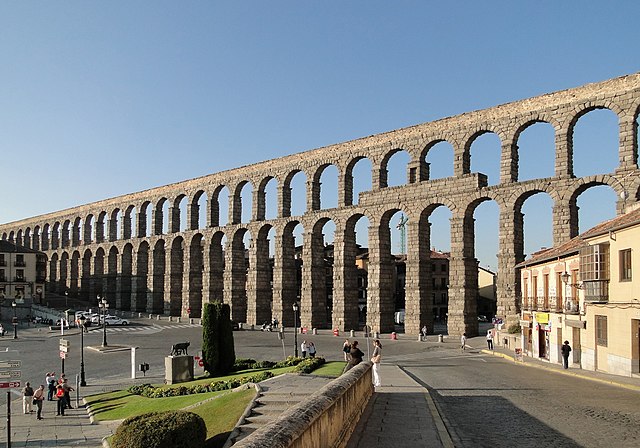Aqueducts are bridges constructed to convey watercourses across gaps such as valleys or ravines. The term aqueduct may also be used to refer to the entire watercourse, as well as the bridge. Large navigable aqueducts are used as transport links for boats or ships. Aqueducts must span a crossing at the same level as the watercourses on each end. The word is derived from the Latin aqua ("water") and ducere, therefore meaning "to lead water". A modern version of an aqueduct is a pipeline bridge. They may take the form of tunnels, networks of surface channels and canals, covered clay pipes or monumental bridges.
Pont du Gard, France, a Roman aqueduct built circa 40–60 CE. It is one of France's top tourist attractions and a World Heritage Site.
Mathur Aqueduct, India, built in 1966
Aqueduct of Vanvitelli, Italy, built by Luigi Vanvitelli. It is a World Heritage Site.
Aqueduct of Segovia
An aqueduct is a watercourse constructed to carry water from a source to a distribution point far away. In modern engineering, the term aqueduct is used for any system of pipes, ditches, canals, tunnels, and other structures used for this purpose. The term aqueduct also often refers specifically to a bridge carrying an artificial watercourse. Aqueducts were used in ancient Greece, ancient Near East, and ancient Rome. The simplest aqueducts are small ditches cut into the earth. Much larger channels may be used in modern aqueducts. Aqueducts sometimes run for some or all of their path through tunnels constructed underground. Modern aqueducts may also use pipelines. Historically, agricultural societies have constructed aqueducts to irrigate crops and supply large cities with drinking water.
The Central Arizona Project carries water from the Colorado River to central and southern Arizona.
Medieval Deccan aqueduct in Hampi
Nabataean aqueduct in Petra, Jordan
The multiple arches of the Pont du Gard, in Roman Gaul. Its lower tiers carry a road across the river, and the upper tiers support an aqueduct conduit that carried water to Nimes







